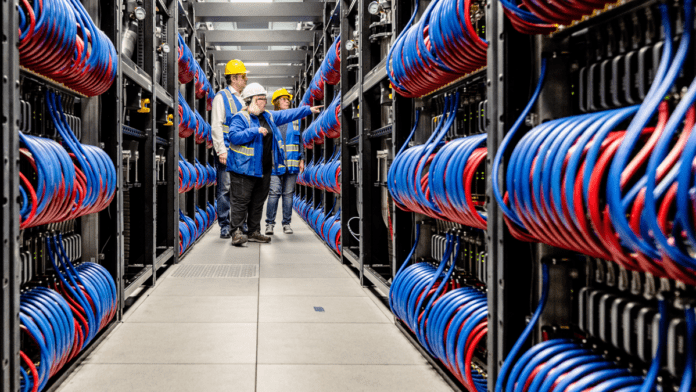Intel has announced that its Aurora supercomputer, developed in partnership with Argonne National Laboratory and Hewlett Packard Enterprise (HPE), has achieved an AI performance of 10.6 AI exaflops, making it the fastest AI supercomputer in the world. The innovative system, which utilises the Intel Data Center GPU Max Series and Intel Xeon CPU Max Series processors, surpassed the exascale barrier at 1.012 exaflops, and has been hailed for its significant contribution to AI-accelerated high performance computing (HPC) and scientific discovery.
- Intel’s Aurora supercomputer, developed in collaboration with Argonne National Laboratory and Hewlett Packard Enterprise, has broken the exascale barrier, achieving 1.012 exaflops and ranking as the fastest AI system in the world dedicated to open science.
- Aurora’s success highlights the importance of open ecosystems in driving AI-accelerated high-performance computing, enabling researchers to harness generative AI models for scientific discovery in areas such as neuroscience, physics and drug design.
- The Intel Data Center GPU Max Series, with its Intel Xe GPU architecture, forms the core of the Aurora supercomputer, optimised for AI and HPC tasks. Intel also promotes an open ecosystem with software tools like oneAPI for diverse hardware platforms, advancing accelerated computing in HPC and AI.
Breaking the Exascale Barrier: Aurora Supercomputer
In the world of high-performance computing (HPC), exascale computing has been the Holy Grail for years. Now, it seems this elusive goal has been achieved by the Aurora supercomputer. Announced at ISC High Performance 2024 by Intel in collaboration with Argonne National Laboratory and Hewlett Packard Enterprise (HPE), Aurora has not only broken the exascale barrier but also ranks as the fastest AI system in the world dedicated to open science.
The Importance of AI-Centric Supercomputing
As quoted directly from Ogi Brkic, Intel vice president, and general manager of Data Center AI Solutions,
“The Aurora supercomputer surpassing exascale will allow it to pave the road to tomorrow’s discoveries. From understanding climate patterns to unravelling the mysteries of the universe, supercomputers serve as a compass guiding us toward solving truly difficult scientific challenges that may improve humanity.”
Indeed, AI-centric supercomputing could be the key to unlocking unprecedented scientific discoveries. With its massive computational power, the Aurora supercomputer allows researchers to harness generative AI models, accelerating scientific discovery. Early successes include mapping the human brain’s 80 billion neurons and accelerating drug design and discovery through machine learning.
Inside the Aurora Supercomputer
The Aurora supercomputer is a behemoth in terms of hardware, featuring 166 racks, 10,624 compute blades, and a staggering 63,744 Intel® Data Center GPU Max Series units. It’s one of the world’s largest GPU clusters and includes the largest open, Ethernet-based supercomputing interconnect on a single system.
At the heart of this impressive system is the Intel Data Center GPU Max Series, underpinned by the Intel Xe GPU architecture. This architecture, which features specialised hardware optimised for both AI and HPC tasks, is pivotal in accelerating matrix operations crucial for deep learning models.
Open Ecosystem and the Future of Accelerated Computing
In a special session at ISC 2024, CEO Andrew Richards of Codeplay, an Intel company, discussed the growing demand for accelerated computing and software in HPC and AI. He highlighted the importance of oneAPI, a unified programming model across diverse architectures built on open standards. This approach aims to break vendor lock-in and foster more open and scalable developments in the field.
Final Thoughts
The Aurora supercomputer breaking the exascale barrier is a significant milestone in the evolution of high-performance computing. It represents a giant leap forward in our ability to tackle complex scientific challenges and paves the way for advancements in numerous fields, from climate science to drug discovery.
At the same time, the focus on an open ecosystem in HPC and AI is a welcome move towards more collaborative and inclusive development. As we push the boundaries of what is possible with computing, it is crucial that we do so in a manner that allows for the broadest possible participation and benefit. The Aurora supercomputer, with its impressive capabilities and commitment to open standards, is an encouraging step in that direction.
FAQ
Q: What is the significance of the Aurora supercomputer in the field of AI?
A: Designed as an AI-centric system, Aurora allows researchers to harness generative AI models to accelerate scientific discovery, such as mapping the human brain’s neurons and enhancing high-energy particle physics.
Q: How powerful is the Aurora supercomputer?
A: The Aurora supercomputer has broken the exascale barrier at 1.012 exaflops, making it the fastest AI system in the world dedicated to open science.
Q: What benchmarks did the Aurora supercomputer excel in?
A: The Aurora supercomputer secured the second spot on the high-performance LINPACK (HPL) benchmark and the third spot on the high-performance conjugate gradient (HPCG) benchmark, showcasing its capabilities in real-world HPC applications.
Q: What technology is at the heart of the Aurora supercomputer?
A: The Aurora supercomputer utilises the Intel Data Center GPU Max Series, featuring the Intel Xe GPU architecture optimized for AI and HPC tasks.
Q: How is AI optimized in the Aurora supercomputer?
A: The Intel Xe GPU architecture in the Aurora supercomputer excels in managing matrix-vector operations crucial for deep learning models, accelerating AI workloads in HPC.
Q: What is the role of the oneAPI programming model in HPC and AI?
A: The oneAPI programming model ensures code runs seamlessly across different hardware platforms without vendor lock-in, empowering developers to leverage accelerated computing in diverse architectures.













